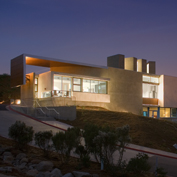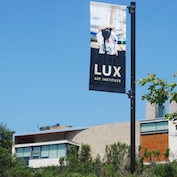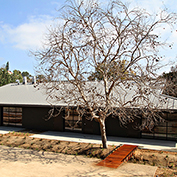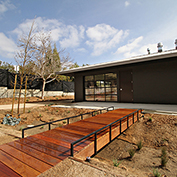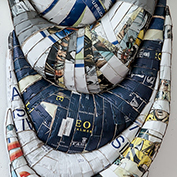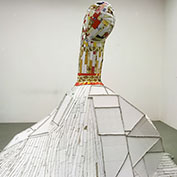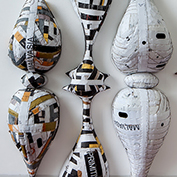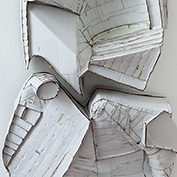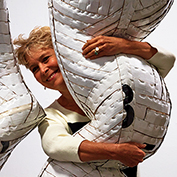News
Melora Kuhn In Residence At Lux
Article Subtitle
New York artist's portraits peer into the complexities of America’s past
Article Date
November 24, 2013
Article Content
Artist in residence Melora Kuhn, works on a collage piece at the studio space at LUX Art Institute in Encinitas. Kuhn is on a fellowship from her home in upstate New York for a month and will be working at the institute during public hours, Thursdays and Fridays from 1pm to 5pm, and Saturdays from 11am to 5pm.
Looking at Melora Kuhn’s portraits is a little unsettling. ■ Whether in the “Producer,” part of a series of images Kuhn did of an imaginary circus troupe, or the “Ellis Island Boy,” which was inspired by a found photograph of an immigrant, you can’t escape their eyes. ■ Are they staring at you or through you? And what do they want? What’s their story? ■ “I did one show that was all portraits,” said Kuhn, who is in residence at the Lux Art Institute in Encinitas through Dec. 7. “It was all girls, and all of them were looking out. And at the end of working on that, I had to put all the paintings facing the wall because I thought everyone was staring at me. ■ “If it’s just one, it’s OK. But when you get a whole bunch, it’s a little overwhelming.” ■ Kuhn, who studied at the School of the Art Institute of Chicago and the Scuola Lorenzo de’ Medici in Florence, has been showing in galleries worldwide since 1999, when her work was included in the Copley Society of Boston’s biennial, Manifest ’99, and 2000, when she had her first solo show at Boston’s Gallery M3. ■ Lux director Reesey Shaw first encountered her work last year at New York’s “Armory Show,” where Kuhn was exhibiting with Galerie EIGEN + ART.
“I was struck by her fresh interpretation of classical subject matter,” Shaw said. “Her reinterpretation of history on the face of the canvas allowed the viewer to see the layering of the past in several ways at once.
“All this played out with intense drama, finesse, innocence and wit.”
At Lux’s studio/gallery, Kuhn is surrounded by an assemblage of work from the last eight years that she calls “Reconstructing Histories.” The eyes are still evident, but since moving from New York City to upstate New York in 2008, she’s become interested — you could say obsessed — with American history and its ever-evolving and elusive nature.
“I never paid much attention to history in high school, but what I’ve been learning has been slowly making its way into my work,” Kuhn said. “The more you read, the more complicated it is. You can’t actually find any kind of black-and-white answers.
“I’m just trying to understand how we got to where we are now, and how it may be able to be pulled apart to figure out a new order, or a new way.”
Differing conclusions
In what may be her most provocative portrait, Thomas Jefferson is not looking at you at all. He’s looking toward the right, seemingly at something out of the frame. But superimposed on Jefferson’s portrait is a line drawing of Sally Hemmings, the slave whose six children Jefferson apparently fathered. Hemmings is looking in the opposite direction.
The Jefferson/Hemmings issue is a prime example of the unsettled nature of history.
Even as recently as the late ’90s, one high-level group of geneticists examined DNA evidence and other material and concluded that Jefferson probably was the father of Hemmings’ children. Another committee commissioned by the Thomas Jefferson Heritage Society came up with the opposite conclusion.
We’ll never have an absolutely definitive answer, but Kuhn’s 2012 portrait, “Sally’s Mark on Tom,” makes the point that the founding father was more complex than we might imagine.
“I felt like once I learned about Sally Hemmings, I couldn’t look at Thomas Jefferson the same way,” she said. “She’s part of his reality. I like the way (in her painting) you can’t really look at one face without seeing the other. It sort of creates this flip back and forth, so his body is her body and her body is his body.”
In the same way she sees Jefferson differently, perhaps we do as well, and in that instant, there’s an opportunity for a new way of thinking.
“To be able to interrupt habitual thinking, that would be the goal,” she said. “It’s just a little interruption, that’s all. I can’t imagine someone is going to go change their life. But you never know.”
Contrasts, contradictions
Early in her career, Kuhn experimented with theater, filmmaking and especially photography. But painting, in part because of its difficulty, proved an irresistible medium for her (even if aspects of her other interests, whether the use of the canvas as a stage or the utilization of photos as source materials, have integrated themselves into her practice).
“In high school I did photography almost exclusively, and I wanted to move into something that was different,” Kuhn said. “I found painting so hard. I took beginning painting three times. But I kept with it because it was something I couldn’t ever begin to get.”
She is only now feeling as if she’s found her own voice — a voice that she sees as influenced by art history, even as it’s turned toward showing some of the complexities of American history.
“I’ve found painting is hugely alive,” she said. “When I’m engaged with a painting, it leads me through all this research, and things just start coming.
“I feel through painting you can actually have a conversation with painters from the past, just by putting down a brush stroke, and I feel as if I really understand what somebody else was saying in a different way.”
She’ll borrow — or as she puts it, steal — images from the past and re-contextualize them. The Jefferson part of “Sally’s Mark on Tom” is taken from one of the many historic portraits of our third president and the primary author of the Declaration of Independence. In one of her works from this year, she’s taken a drawing room that is a common backdrop in countless European paintings from previous centuries, and a pack of dogs also reminiscent of an earlier style. But she’s put them together in “The Wolf’s Cry,” with the pack of dogs attacking a wolf in a high-class salon.
“The wolf was a sacred animal for Native Americans,” she said. “But also, throughout history, it’s the predator that everyone wants to get rid of.”
The juxtaposition of civilization and savagery is what gives the painting its impact and its meaning.
“I think the wolf could be a stand-in for any number of things, actually,” Kuhn said.
And as you look at the painting, you realize the distressed wolf is looking right at you.
What should you do? What would you do?
jim.chute@utsandiego.com Twitter: @sdutchute Facebook.com/utartmusic
In the Press
October 25, 2014
January 20, 2014
December 17, 2013
November 24, 2013
November 20, 2013
November 13, 2013
November 1, 2013
September 18, 2013
News from Lux
January 25, 2013
September 1, 2011





